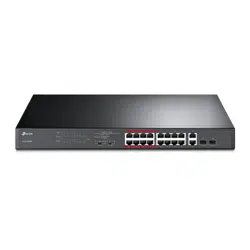Loading ...
Loading ...
Loading ...

4
Unmanaged PoE+ Switch
Introduction
LED Indication
PoE Status
On: The port is connecting to a PD and supplying power for it.
Flashing: The PoE power circuit may be in short or the power current may be overloaded.
Off: No PD is connected to the corresponding port, or no power is supplied according to
the power limits of the port.
PoE Max
On: Total power supply ≥ 243 W.
Flashing: Total power supply ≥ 243 W and lasts for more than 2 minutes.
Off: Total power supply ≤ 243 W.
Switches
Switch Indication
Extend Mode
Extend Mode switch 1–8, 9–16 and 17–24 can control the rate and power supply distance
of corresponding ports.
Off: The corresponding ports (1–8/9–16/17–24) run at 10/100 Mbps and support PoE
power supply up to 100 m away.
On: The corresponding ports (1–8/9–16/17–24) run at 10 Mbps and support PoE power
supply up to 250 m away.
Priority Mode
(1–8)
Off: All the ports transmit data with the same priority.
On: Port 1–8 transmit data with a higher priority than Port 9–24. When congestion occurs,
packets which are transmitted by the ports with a higher priority occupy the whole
bandwidth.
Isolation
(1–24)
Off: Port 1–24 can transmit data with every port.
On: Port 1–24 cannot transmit data with each other. They can transmit data only with port
25–26.
Recovery
(1–24)
Off: The PoE Auto Recovery function is disabled.
On: The switch will constantly detect the working status of a PoE powered device (PD).
When the switch finds that the PD works abnormally, the switch will reboot it.
10/100 Mbps RJ45 Port (Port 1–24)
The ports are designed to connect to devices with a bandwidth of 10 Mbps or 100 Mbps. The ports can
provide power and transmit data for PDs. The maximum PoE power is 30 W for each PoE port and 250 W
for all the PoE ports. The ports can also connect to non-PoE devices, but only transmit data.
10/100/1000 Mbps RJ45 Port (Port 25–26)
The ports are designed to connect to devices with a bandwidth of 10 Mbps, 100 Mbps or 1000 Mbps.
SFP Port (Port 25F–26F)
The ports are designed to install the SFP module. An SFP Port (Port 25F–26F) and the associated
10/100/1000 Mbps RJ45 Port (Port 25–26) are called a “Combo” port, which means they cannot be used
simultaneously; otherwise, only the SFP port works.
Loading ...
Loading ...
Loading ...
